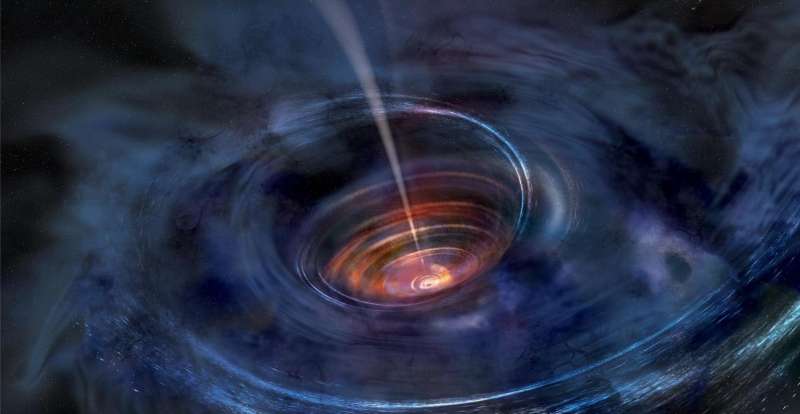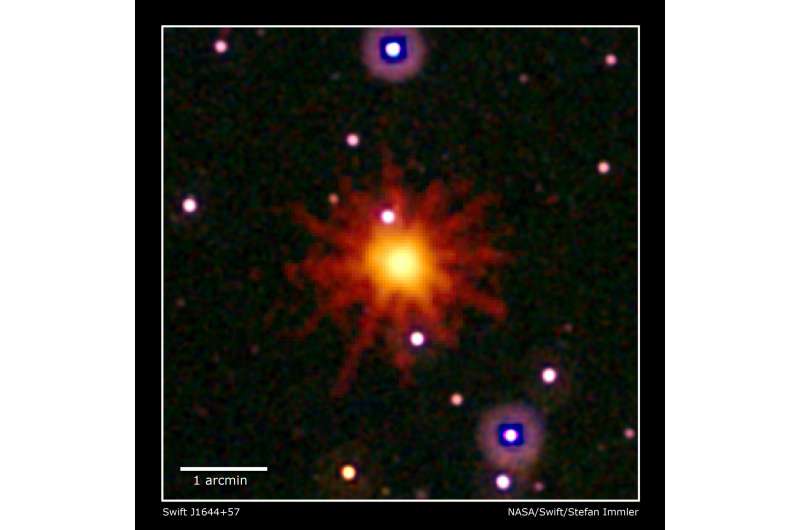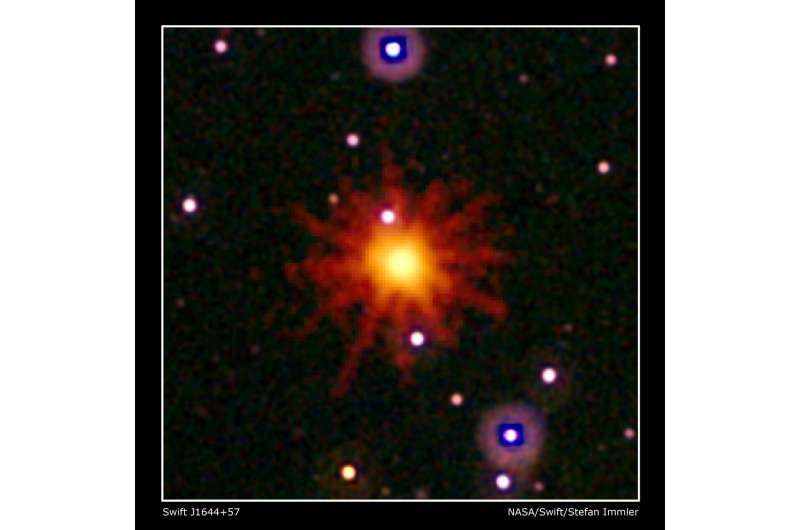Dormant black hole eats star, becomes X-ray flashlight

Roughly 90 percent of the biggest black holes in the known universe are dormant, meaning that they are not actively devouring matter and, consequently, not giving off any light or other radiation. But sometimes a star wanders too close to a dormant black hole and the ensuing feeding frenzy, known as a tidal disruption event, sets off spectacular fireworks.
Astronomers from the University of Maryland and the University of Michigan are the first to document X-rays bouncing around deep within the walls of a once-dormant black hole's newly formed accretion disk—the giant, puffy cloud of shredded star stuff circling the black hole, waiting for its turn to be swallowed up—following a tidal disruption event. Using these data, the researchers discerned the shape and activity of the accretion disk near a supermassive black hole named Swift J1644+57.
This marks the first time such detailed observations have been made for a dormant supermassive black hole. In addition, the team's methodology could open the door to reliable measurements of black hole spin in the near future. The results are published in the June 22, 2016 advance online edition of the journal Nature.
"Most tidal disruption events don't emit much in the high-energy X-ray band. But there have been at least three known events that have, and this is the first and only such event that has been caught at its peak," said Erin Kara, a Hubble Postdoctoral Fellow in astronomy at UMD and the Joint Space-Science Institute and lead author on the study. "NASA's Swift satellite saw it first and triggered the European Space Agency's XMM-Newton satellite and the Japanese Aerospace Exploration Agency and NASA's Suzaku satellite to target it for follow-up. So we have excellent data. We're lucky that the one event we have is showing us all these exciting new things."
The accretion disk has an effect somewhat like the reflective shield behind a flashlight bulb, reflecting, amplifying and focusing the radiation. The fact that X-rays can originate deep within the accretion disk of a tidal disruption event is surprising, according to Kara. Conventional wisdom among astronomers has long held that, during a tidal disruption event, high-energy X-rays are created further from the black hole in the relativistic jets—huge beams of particles ejected by the black hole and accelerated to nearly the speed of light. But seeing X-ray emissions bouncing off the walls of the inner accretion disk has cast a new light on this assumption.
"Before this result, there was no clear evidence that we were seeing into the innermost regions of the accretion disk," Kara said. "We thought the emission was from the jet pointed at us, or further away and not close to central black hole. This new study shows us that, actually, we can see this reverberation at work very close to the central black hole."

To date, most of what astronomers know about supermassive black holes comes from a relative handful of black holes that are actively gathering and consuming matter. Evidence suggests, however, that these active black holes only account for about 10 percent of the total population of supermassive black holes in the universe. So any data from a dormant black hole is incredibly valuable to astronomers, in their effort to understand all types of black hole activity.
"Understanding the black hole population in general is important. Black holes have played an important role in how galaxies evolved. So even if they're dormant now, they weren't before," said Chris Reynolds, a professor of astronomy at UMD and a Fellow at the Joint Space-Science Institute who is a co-author on the study. "If we only look at active black holes, we might be getting a strongly biased sample. It could be that these black holes all fit within some narrow range of spins and masses. So it's important to study the entire population to make sure we're not biased."
Swift J1644+57 consumed the material from the shredded star so quickly, the event briefly exceeded the Eddington Limit—the theoretical maximum "speed limit" that defines how fast a black hole can consume matter. This finding can help astronomers to understand how supermassive black holes grow to their enormous masses—up to several million times the mass of the sun.
"The meaning of this extends far beyond the studies of tidal disruption events," said Lixin Dai, a postdoctoral associate in physics at UMD and the Joint Space-Science Institute who is a co-author on the study. "It can help us understand how the biggest black holes in the universe formed and co-evolved with their host galaxies."
The team used X-ray reverberation mapping to chart out the inside of the accretion disk. Much like sound waves can be used to map the seafloor or canyons by measuring the time delays of sound echoes, Kara, Reynolds and their colleagues computed small delays in the arrival time of X-ray signals reflected from iron atoms in the accretion disk.
"We know how sound echoes in a large auditorium, for example. Because we know the speed of sound, we can use the time delay information to calculate the shape of the auditorium," Kara explained. "We are doing the same with X-ray radiation to map out the inner accretion disk. It's a cool, novel technique that has only been developed within the last six years."

Although the researchers have not yet been able to measure the spin of the black hole with reverberation mapping, they say the method could be used to make such measurements in the near future. By imaging the activity of the accretion disk immediately next to the black hole—which would be strongly affected by the black hole's spin—the method could be used to directly measure the speed and direction of spin.
"Looking at tidal disruption events with reverberation mapping might help us probe the spin of black holes in the future," Reynolds said. "But just as importantly, we can follow along after an event and watch how the accretion disk spins down and energy dissipates as the black hole returns to a quiescent state. We might finally be able to observe all of these various states that, so far, we only know from theory textbooks."
More information: "Relativistic Reverberation in the Accretion Flow of a Tidal Disruption Event," Erin Kara, Jon Miller, Chris Reynolds and Lixin Dai, was published in the journal Nature on June 22, 2016. nature.com/articles/doi:10.1038/nature18007
Journal information: Nature
Provided by University of Maryland


















